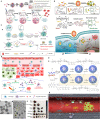Tumor microenvironment penetrating chitosan nanoparticles for elimination of cancer relapse and minimal residual disease
- PMID: 36531004
- PMCID: PMC9751059
- DOI: 10.3389/fonc.2022.1054029
Tumor microenvironment penetrating chitosan nanoparticles for elimination of cancer relapse and minimal residual disease
Abstract
Chitosan and its derivatives are among biomaterials with numerous medical applications, especially in cancer. Chitosan is amenable to forming innumerable shapes such as micelles, niosomes, hydrogels, nanoparticles, and scaffolds, among others. Chitosan derivatives can also bring unprecedented potential to cross numerous biological barriers. Combined with other biomaterials, hybrid and multitasking chitosan-based systems can be realized for many applications. These include controlled drug release, targeted drug delivery, post-surgery implants (immunovaccines), theranostics, biosensing of tumor-derived circulating materials, multimodal systems, and combination therapy platforms with the potential to eliminate bulk tumors as well as lingering tumor cells to treat minimal residual disease (MRD) and recurrent cancer. We first introduce different formats, derivatives, and properties of chitosan. Next, given the barriers to therapeutic efficacy in solid tumors, we review advanced formulations of chitosan modules as efficient drug delivery systems to overcome tumor heterogeneity, multi-drug resistance, MRD, and metastasis. Finally, we discuss chitosan NPs for clinical translation and treatment of recurrent cancer and their future perspective.
Keywords: chitosan; drug delivery; minimal residual disease; recurrent cancer; tumor heterogeneity; tumor microenvironment.
Copyright © 2022 Mahmudi, Adili-Aghdam, Shahpouri, Jaymand, Amoozgar and Jahanban-Esfahlan.
Conflict of interest statement
The authors declare that the research was conducted in the absence of any commercial or financial relationships that could be construed as a potential conflict of interest.
Figures












Similar articles
-
Chitosan-based nanoparticles for tumor-targeted drug delivery.Int J Biol Macromol. 2015 Jan;72:1313-22. doi: 10.1016/j.ijbiomac.2014.10.052. Epub 2014 Nov 3. Int J Biol Macromol. 2015. PMID: 25450550 Review.
-
RGD functionalized chitosan nanoparticle mediated targeted delivery of raloxifene selectively suppresses angiogenesis and tumor growth in breast cancer.Nanoscale. 2020 May 21;12(19):10664-10684. doi: 10.1039/c9nr10673a. Epub 2020 May 6. Nanoscale. 2020. PMID: 32374338
-
Potential of Chitosan and Its Derivatives for Biomedical Applications in the Central Nervous System.Front Bioeng Biotechnol. 2020 May 5;8:389. doi: 10.3389/fbioe.2020.00389. eCollection 2020. Front Bioeng Biotechnol. 2020. PMID: 32432095 Free PMC article. Review.
-
Effects of tumor microenvironments on targeted delivery of glycol chitosan nanoparticles.J Control Release. 2017 Dec 10;267:223-231. doi: 10.1016/j.jconrel.2017.09.015. Epub 2017 Sep 14. J Control Release. 2017. PMID: 28917532
-
Cancer-targeted MDR-1 siRNA delivery using self-cross-linked glycol chitosan nanoparticles to overcome drug resistance.J Control Release. 2015 Jan 28;198:1-9. doi: 10.1016/j.jconrel.2014.11.019. Epub 2014 Dec 4. J Control Release. 2015. PMID: 25481438
Cited by
-
A rapid protocol for synthesis of chitosan nanoparticles with ideal physicochemical features.Heliyon. 2024 Jun 3;10(11):e32228. doi: 10.1016/j.heliyon.2024.e32228. eCollection 2024 Jun 15. Heliyon. 2024. PMID: 38961950 Free PMC article.
-
Targeting Cancer Stemness Using Nanotechnology in a Holistic Approach: A Narrative Review.Pharmaceutics. 2025 Feb 20;17(3):277. doi: 10.3390/pharmaceutics17030277. Pharmaceutics. 2025. PMID: 40142941 Free PMC article. Review.
-
Advanced drug delivery platforms target cancer stem cells.Asian J Pharm Sci. 2025 Jun;20(3):101036. doi: 10.1016/j.ajps.2025.101036. Epub 2025 Feb 19. Asian J Pharm Sci. 2025. PMID: 40503056 Free PMC article. Review.
-
Extracellular matrix: unlocking new avenues in cancer treatment.Biomark Res. 2025 May 27;13(1):78. doi: 10.1186/s40364-025-00757-3. Biomark Res. 2025. PMID: 40426238 Free PMC article. Review.
-
Drug Loading in Chitosan-Based Nanoparticles.Pharmaceutics. 2024 Aug 6;16(8):1043. doi: 10.3390/pharmaceutics16081043. Pharmaceutics. 2024. PMID: 39204388 Free PMC article. Review.
References
Publication types
LinkOut - more resources
Full Text Sources

